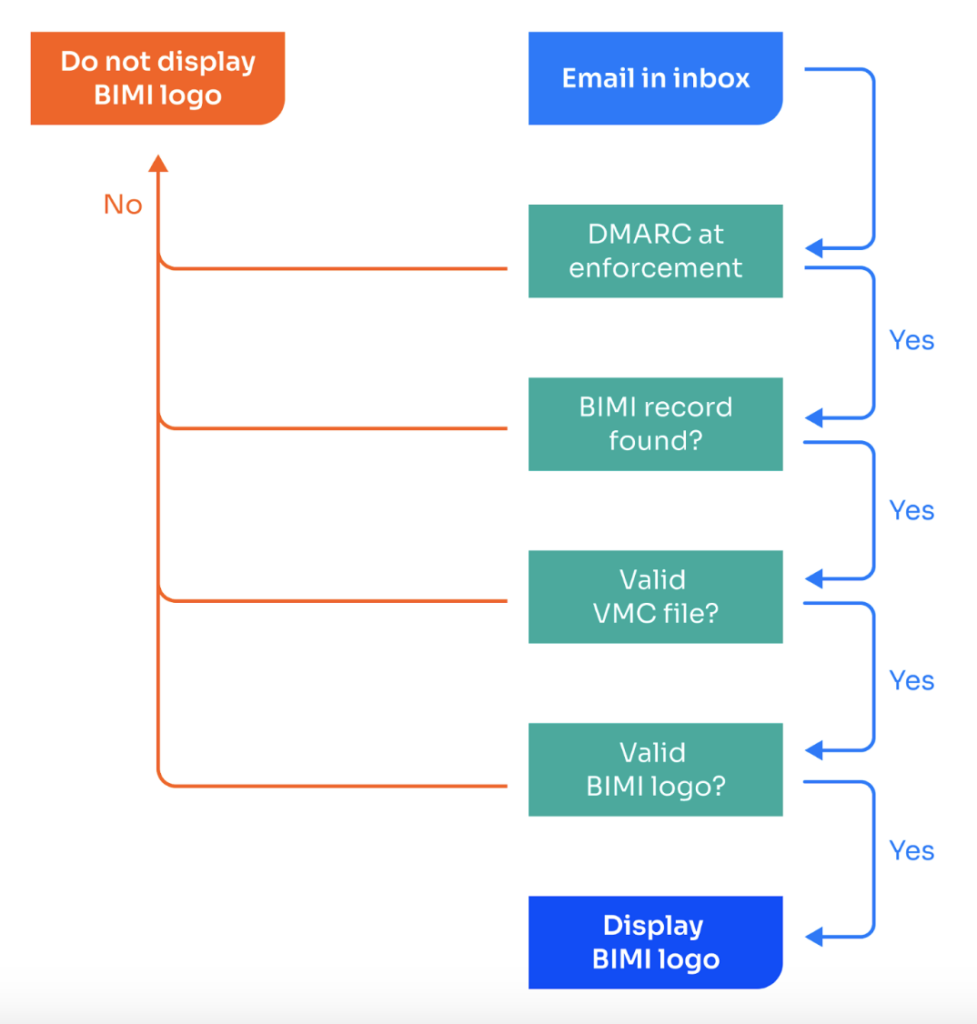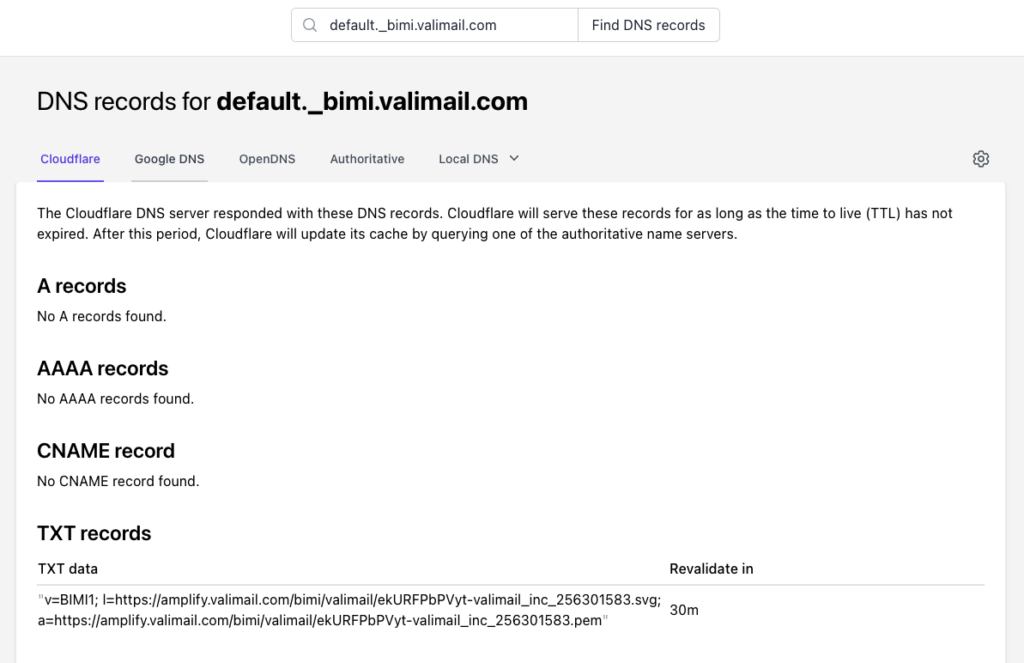- Guide
Email Branding: Best Practices
Email branding is the practice of communicating your brand in a consistent, pleasing way through email. Some classic examples of how to communicate branding through email include:
- Display your company’s logo.
- Stick to a consistent voice and style.
- Link to your brand’s official social media.
- Use colors and fonts associated with your brand.
- Communicate in a way that’s consistent with your brand’s values.
Email branding has always been a place of rapid innovation, and the newest technology in this space is BIMI (Brand Indicators for Message Identification). BIMI allows you to display branded logos next to your organization’s emails in recipients’ inboxes.

This article explains how a cutting-edge email marketing technology (BIMI) fits into the context of traditional email branding. We hope you’ll leave with an understanding of how BIMI can take your email branding strategy to the next level. However, BIMI also requires time, money, and technical effort. To address that challenge, we’ll help you understand whether the investment is worth it for your brand, how to set BIMI up, and where to learn more.
Summary of key BIMI email branding concepts
Modern email branding with BIMI requires using technologies like the DNS (Domain Name System) , public-key cryptography, and email security best practices (like DMARC). Thus, BIMI comes with challenges beyond crisp design, expressing your brand’s unique voice, and aligning with the brand’s values that are fundamental to email branding.
Let’s briefly summarize some of the core technologies that make BIMI possible. You can use this table as a reference throughout the article if you get confused about a specific technical term.
| Term | Meaning |
|---|---|
| BIMI Record | A DNS record that tells inboxes where to find your logo and VMC. |
| DNS (Domain Name System) | A system for looking up domain names to find their IP addresses and other information (like mail servers, BIMI, and DMARC records) |
| VMC (Verified Mark Certificate) | A special, cryptographic file that proves that your organization is the legitimate owner of the branded logo. |
| DMARC (Domain-based Message Authentication, Reporting & Conformance) | A framework that uses the DNS to authenticate email. DMARC is a prerequisite for using BIMI. You can learn more about DMARC and other email security best practices with our guide: Email Security Best Practices. |
How BIMI strengthens your brand
BIMI (pronounced Bih-mee) improves your email branding in two main ways.
- Visibility
Most email users today have inboxes full of mail. A flurry of marketing content, social media notifications, and work meetings compete for readers’ attention. How can you make your messages stand out and command the attention of your audience?
Your content is easily distinguishable from the pack by displaying a branded logo next to emails. BIMI was created with marketing in mind – recall that the acronym stands for Brand Indicators for Message Identification. The purpose of BIMI is to empower recipients to easily identify your company’s messages using indicators (i.e., logos) associated with your brand.
- Trust
When users see a BIMI logo displayed next to an email, their confidence in your email’s legitimacy and authenticity is instantly boosted. They know that the email is protected by DMARC, a robust email authentication protocol that BIMI requires. Furthermore, you probably had to undergo a lengthy verification process to receive the special cryptographic file verifying your right to use the trademarked logo.
Of course, the two points above only cover the end result. The technical, behind-the-scenes details of how BIMI does its work is another story entirely. A thorough technical exposition of BIMI is beyond the scope of this article; however, you can find such deep dives by accessing the other chapters in this guide: Guide to BIMI.
BIMI behind-the-scenes
To give you an idea of all the steps an inbox goes through when determining whether to display a BIMI logo, consider the flowchart below.

If any of these steps are skipped, the security promises of BIMI are weakened. Sometimes, they really are skipped. For example, not all mail platforms require the presence of a valid VMC file in order to display a BIMI logo.
Nevertheless, this behavior is already declining, and platforms are converging around strong BIMI compliance and adherence to the highest security standards.
One component of BIMI that must be present is the BIMI record. A BIMI record is a DNS record that lets inboxes know where they can find your logo image file on the web and your VMC file. You can look up a BIMI record by doing a DNS query of the default._bimi subdomain. To demonstrate this, we can use an online DNS tool like NsLookup.io.

The BIMI record is in the section titled “TXT records.” In the screenshot above, that’s at the very bottom. The BIMI record looks like this:
v=BIMI1; l=https://amplify.valimail.com/bimi/valimail/ekURFPbPVyt-valimail_inc_256301583.svg; a=https://amplify.valimail.com/bimi/valimail/ekURFPbPVyt-valimail_inc_256301583.pem
This might look like gibberish at first glance. You can learn more about the syntax and use of BIMI records in our BIMI Record article.
BIMI email branding recommendations
Although the idea of how BIMI works is relatively straightforward, getting all of the steps and prerequisites right can be tricky if you’ve never done it before. To help you navigate this trickiness, we’ve prepared some tips and tricks to help you get BIMI right, even if it’s your first time working with an email security protocol.
Use DMARC
Enabling DMARC makes it harder for attackers to spoof your email domain.This alone is a great reason for you to set up DMARC. Additionally, DMARC is a prerequisite for BIMI. DMARC is essential for BIMI because you don’t want people impersonating a domain to display that domain’s BIMI logo next to their spam emails.
Even if you haven’t decided whether to deploy BIMI, you should consider deploying DMARC to protect your domain from impersonation.
You can learn more about DMARC and other email security tools in our Email Security Best Practices guide.
Get a Verified Mark Certificate (VMC)
When you see a BIMI logo next to an email, you have a boost of confidence that the email comes from the organization that actually owns that trademark. The Verified Mark Certificate, or VMC, justifies this confidence.
Most mail platforms will only display a BIMI logo if the domain’s BIMI record points to a VMC file. VMC files can only be obtained from a special certificate authority (CA).
Suppose you want to obtain a file from the CA. In that case, you have to go through a verification process, including showing your legal identification in a video call, demonstrating ownership of the trademarked logo, and paying $1,499 USD.
In our guide, Verified Mark Certificate, you can learn more about how a VMC works, where to get one, and how to deploy it.
Understand logo requirements
The basic function of BIMI is displaying your logo next to your company’s emails in recipients’ inboxes. There are various rules restricting what kind of image file you can use and how the file must be formatted.
For example, the image must adhere to the standards below.
- Obey the custom SVG P/S file format.
- Be no larger than 32 KB in size.
- Contain a trademarked logo that you (or your organization) own.
There are many more minor requirements laid out in the BIMI specification. You can learn more by reading our BIMI Logo article.
Use secure web hosting
Back in the day, if someone joined your network, they could see all the traffic. There was no encryption to prevent someone from seeing the password you supplied to a website when you logged in, for example. Alternatively, someone who controls an intermediary router might alter traffic before you send or receive it to the destination.
Encryption protocols like SSL and TLS solve these problems. When you use SSL/TLS with traditional HTTP (the protocol that powers the web), it’s called HTTPS.
You don’t want an attacker modifying the logo before it’s displayed in an inbox. Thus, it’s required that you serve your logo via a web server that has HTTPS enabled. For similar reasons, you must also make your VMC accessible via HTTPS.
Choose a simple solution for easily getting your logo in inboxes
Implement BIMI at a fraction of the cost and time compared to deploying it manually
Increase open-rates and visibility for your marketing content
Conclusion
Email branding traditionally consists of “soft skills” like consistent voice, color palette, and social media management. In recent times, new technologies are dramatically changing the email branding landscape. Among these new technologies is BIMI (pronounced Bih-mee), a protocol allowing marketers to display branded logos next to emails in recipients’ inboxes.
However, this powerful technology requires that you acquire some basic technical skills related to email administration. For example, setting up BIMI requires enabling DMARC, acquiring a VMC, and serving your logo via HTTPS.
Don’t let this discourage you – BIMI is a practical way to turbocharge your brand’s marketing power. First, the presence of BIMI increases confidence among recipients that your emails are legitimate and not phishing spam. Second, your emails stick out in inboxes. BIMI increases visibility and makes recipients more likely to notice and open your emails.
Explore the chapters:
- 1. Introduction - BIMI Email: Tutorial & Examples
- 2. Verified Mark Certificate: Tutorial & Examples
- 3. BIMI Logo
- 4. What is BIMI?
- 5. BIMI - A New Protocol for Email Marketing
- 6. BIMI Generators - Using Automated Tools To Manage BIMI
- 7. Email Branding
- 8. BIMI Checker
- 9. Brand Indicators For Message Identification: Best Practices
- 10. Using BIMI with Apple Mail
- 11. BIMI Email Security
Get started for free
with Monitor
Start your path to DMARC enforcement with a panoramic view of the traffic being sent on your behalf.
No trial offers, credit cards, or obligations.
Explore all Valimail
has to offer
Go one step further than visibility…Take action! Reach DMARC enforcement faster. Stay compliant with evolving sender requirements. All while protecting your brand.